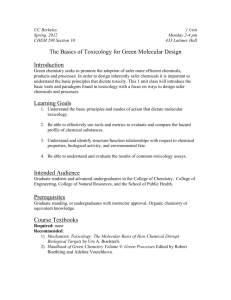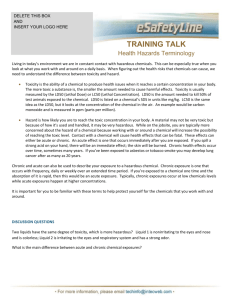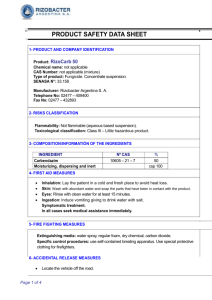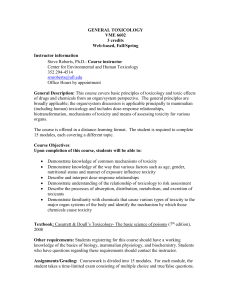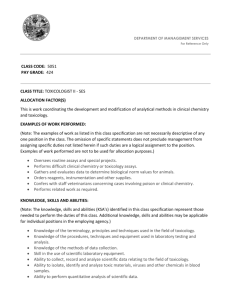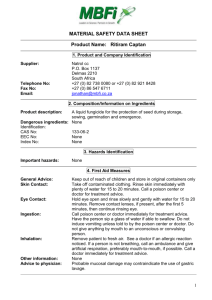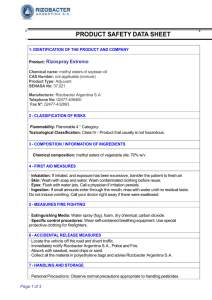Toxicology, genetic toxicology
advertisement
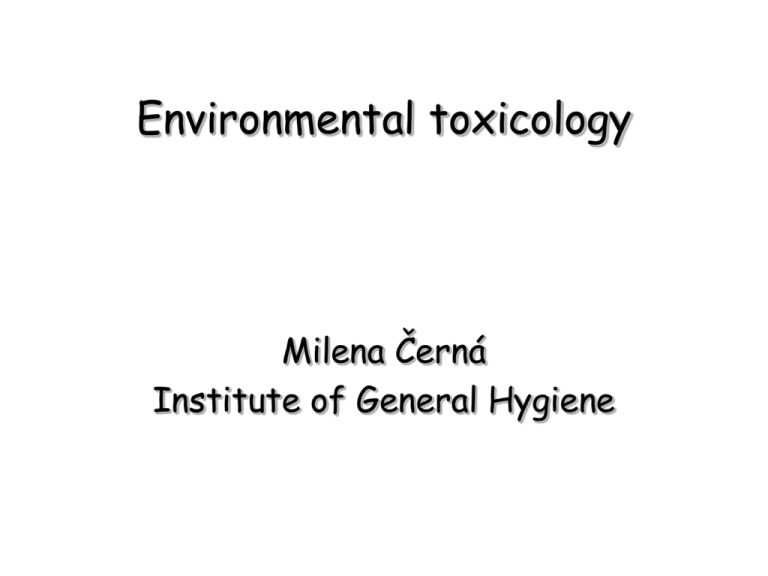
Environmental toxicology Milena Černá Institute of General Hygiene Definition of toxicology Toxicology is, scientific discipline focused chemical and biological interactions of environmental stressors with human being. The history of toxicology is very long – the poisons were studied and used in many ancient cultures. Poisons were used in policy or as tools for solving private problems. Taxus (yew-tree) – toxon (bow) – toxicon (poison for arrow) History of toxicology Ancient Egyptians – hydrogen cyanide from peach stone Sokrates – decoct from Conium maculatum (hemlock) Nero – arsenic Claudius and Aggripina – intoxication with mushrooms Theophrastus Bombastus von Hohenheim (1493-1541) known as Paracelsus Dosis facit venenum (the doce alone makes a thing poisonous) Further development of toxicology Scientific development in the frame of chemistry and pharmacy Occupational toxicology – carbon monooxide poisoning in mines, in metal-processing industries Italian physician Bernardo Ramazzini (1633-1714) described the diseases of workers (1700) do precisely that the text remained a textbook of occupational hygiene for a century Percival Pott (1714-1788) described soot as the cause of skin cancer on the scrotum of London chimney sweeps. Diversification of toxikology General t. – a study of common regularities, theories and conseqiences: mechanisms of effects, biotransformation, exposure, interactions of chemical compounds, etc. Development of methods to study toxici effects. Special t. – description, study and evaluation of toxic effects of particular chemicals and preparations. Environmental t. – (entox) is a multidisciplinary field of science concerned with the study of the harmful effects of various chemical, biological and physical agents on living organisms Ecotoxicology – subdiscipline of environmental t. investigating the effects of toxicants at the ecosystem level Analytical t. – detection of chemicals in the environmental media and human body Diversification of toxikology (cont.) Experimental t. – study of effects of chemicals by means of in vivo or in vitro experiments. Clinical t. – study of effects of chemicals on human being Industrial t. – examines the toxic effects of raw material, products, interproducts and waste in industry. Importants for occupational medicine. Forensic t. in forensic medicine Military t. – chemical warfare agents and their antidota Predictive t. – an assessment of potential effects by meant of alternative methods (quantitative structure – activity relationship QSAR, in silico) Pharmacological toxicology Health effects of chemical compounds Acute – subacute- chronic toxicity Systemic toxicity (organ-specific) Stochastic – nonstochastic (thresholds) effects Delayed effects ) – mutagenic (genotoxic) - carcinogenic - allergenic Environmental toxicology Toxicological adverse effects of environmental toxicants depend on the exposure Exposure is defined as contact over time and space between a person and an environmental toxicants Dose is the amount of toxicant entering the human body. Exposure ways are: • Inhalation • Ingestion • Transport through skin and mucosa • transplacentally Fate of chemical in human body ADME • Absorption • Distribution • Metabolism (biotransformation) • Excretion ADME Absorption - Resorption depends on the exposure way on the bioavailability of compound Bioavailability – the rate and extent to which a substance becomes available to target organ/cell on the distribution of compound in body compartments ADME Toxicokinetics (pharmacokinetics) – what the body does with the substance (absorption, distribution, biotransformation, excretion) Clearence – measure of the body´s ability to eliminate a substance Age- or gender- related dependency of kinetics Effect of low doses in humans Toxicology Toxicodynamics (pharmacodynamics) -what the substance does to the body (effects and mechanisms of actions): Stochastic or non-stochastic effect (threshold) Organ-specific toxic effect Age-related differences in kinetics (children, elderly) Acute – subchronic – chronic effect Delayed effect: mutagenic, carcinogenic, teratogenic, allergenic Xenobiotic metabolism Biotransformation: Phase I: oxidation, reduction, hydrolysis (more water soluble interproducts) Phase II: conjugation Biotransformation via intestinal microflora: reduction, deconjugation Enzymes implicated in xenobiotic metabolism Phase 1 P450-dependent monooxigenases (CYP) Flavin containing monooxygenases (FMO) Monoamine oxiases (MAO) Cyclooxygenases (COX) Phase II Glutation-S-transferases (GST) UDP-glucuronosyltransferases (UGT) Sulfotransferases (SULT) Acetyltransferases (AT) Acyl-CoA aminoacid N-acyltransferases methyltrasferases Factors influencing xenobiotic metabolism: Induction of expression of the enzyme protein (upregulation) Repression of the expression of the enzyme protein (downregulation) Direct activation of the enzymatic function Direct inhibition of the enzymatic function Genetic polymorphisms Cytochromes P450 Interspecies differences Ethnical differences Gender-related differences GST Six families (GSTM, GSTT N-acetyltransferases (NAT-1, NAT-2) NAT-2 slow acetylator, rapid acetylator Free radicals Chemical entities with one or more unpaired electrons. Biological efects: reaction with virtually all molecules in living cells. Cytotoxic and genotoxic effects Damage of cellular membranes, Interaction with proteins, Interaction with lipids (lipid peroxidation) The degree of damage will depend on the balance between radical formation and radical inactivation Genetic toxicology Genotoxic carcinogens DNA interactions DNA adducts and mutations DNA repair Tumor iniciators – stochastic effect Tumor promotors – threshold effect Complete and incomplete carcinogens Contribution of environmental factors to the etiology of cancer (Doll and Peto, 1981) Factor Mean estimate % Ranges Smoking 30 25 - 40 Nutrition 35 10 - 70 Alcohol 3 2-4 Sexual behavior 7 1 - 13 Occupat. exp. 4 2-8 Food additives 1 -5 - 2 Environ. pollution 2 1-5 Industrial products 1 1-2 Medical drugs, therapy 1 0,5 - 3 10? 1-? Geophys. factors 3 2-4 Unknown 3 ? Infection Detection of carcinogenic characteristic of the environmental factors Epidemiological study Testing on animals In vitro tests Classification of carcinogenicity (IARC, US EPA) Chemical carcinogens Type Example Genotoxic: Direct Indirect Alkylating agents PAHs, Aromatic amines, nitroarenes, mycotoxins Inorganic carcinogens Ni, Cr, Cd, As Epigenetic (nongenotoxic): Cytotoxic Mitogens, proliferating agens Solid bodies, fibres Asbestos Tumor promotors TCDD, DDT Hormones Estradiol, DES Immunosuppressant Azathioprine, cyclosporin A Peroxisome proliferators Phthalates, clofibrate IARC Monographs, 2004 Group 1 – carcinogenic to humans Elements and their compounds: Arsenic, beryllium, Cadmium, Chromium VI, Nickel. Drugs (cytostatics): azathioprine, chlornaphazine, cyclosporin, cyclophosphamide, methyl-CCNU, Melphalan, Methoxypsoralen, Myleran, MOPP. Hormonals: diethylstilbestrol, oestrogens, oral contraceptives, tamoxifen*. Organics: 4-aminobiphenyl, benzene, benzidine, bischlormethylether, ethylene oxide, mustard gas, 2-naphtylamine, 2,3,7,8-TCDD, thiotepa, vinyl chloride, formaldehyde Miscelaneous: aflatoxins, asbestos, radon, silica (inhaled in the form of quartz or cristobalite from occ. sources), talc with asbestiform fibres, solar radiation Group 1 – carcinogenic to humans continued Biological factors: Epstein-Barr virus, Hepatitis B, C (chronic inf.), HIV 1, Human papilomavirus type 16,18, Helicobacter pylori, Opisthorchis viverrini, Schistosoma haematobium. Mixtures: Alcoholic beverages, analgesic mixtures with phenacetin, betel quid with tobacco, coal-tar pitches, coaltars, mineral oils, salted fish (Chinese style), soots, tobacco products, tobacco smoke, wood dust. Group 1 – carcinogenic to humans –(cont.) Exposure circumstances: Aluminium production, Auramine manufacturing, Boot and shoe manufacture and repair, Coal gasification, Coke production, Furniture and cabinet making, Haematite mining (radon) Iron and steel founding, Isopropanol manufacturing, Magenta, manufacture, Painter (occup. exposure), Rubber industry, Occ. exp.to strong inorganic acid mists containing sulfuric acid Workplace carcinogens Agent Aromatic amines Arsenicals Tumor location Urinary bladder Lung, skin Asbestos Benzene Diesel exhaust Nickel Vinyl chloride Hair dyes Mineral oils Lung, mesothelioma Industry Rubber Glass, metals, pesticides Insulation Leukemia Solvent, gasoline Lung Engine operation Lung Metals Liver (angiosarcoma) Plastics Bladder Hairdressers skin Metals Monitoring of exposure to environmental chemicals Determination of environmental pollutants in environmental media (air, water, food, soil) Calculation of exposure based on the concentration of chemical and amount of environmental media comming to the body through 24 hours. Human biomonitoring – biomonitoring of exposure Measurement of chemical or its metabolites in human body fluids External exposure – internal dose – biol. target dose – biol. Effect – impaired biol. function - clinical disease Biomarkers of exposure ■ compound itself or its more polar metabolites (example - Pb in blood) ■ volatile compounds in expired air ■ covalent adducts with macromolecules (DNA, proteins – hemoglobin, albumin) Biomarkers of early biochemical effect Biomarkers of bioactive dose ■ delta-aminolevulic acid in urine: increase in Pb exposure ■ acetylcholinesterase activity in erytrocytes: decrease after the exposure to organophosphates ■ specific antibodies in plasma after the exposure to alergens Biomarkers of adverse effects: ■ liver enzymes in plasma: increase after the exposure to hepatotoxic compounds ■ -microglobulin in urine: renal damage after the exposure to Cd Biomarkers of susceptibility Biotransformation enzymes with polymorphisms: ■ acetyltransferases ■ P450 ■ glutathiontransferases ■ epoxidhydrolases Example.: Carcinogenic aromatic amines (benzidin etc.) are metabolic activated by means of flavinmonooxygenases to nitrosoarenes which then react with DNA. The detoxicated metabolic pathway is acetylation by means of acetyltransferases. Persons who are low acetylators are in the increased risk of urinary bladder carcinoma. Dose – response curves Stochastic effect –without threshold. Probability of adverse effect increases with the dose since the beginning (mutagenicity, carcinogenicity) Non-stochastic effect – with threshold. Effect can be observed when the dose reaches certain level. Biological exposure tests in CR / Legislation limit values BET in urine Biological exposure tests in CR / Legislation limit values of BET in urine (cont.) Biological exposure tests in CR / Legislation limit values in blood Metals Toxic metals: Cadmium, Lead, Mercury, Arsenic Essential metals: Copper Zinc selenium Mercury Elemental mercury vapor. Acute toxicity: inhalation - rare, pneumonia, emphysema, orally – GIT problems Chronic: akrodynia, nephrotic syndrome, gingivitis, tremor mercurialis, erethism, polyneuropathy Mercury salts: Acute: Orally erosive effect, hemorrhagic vomiting, renal damage Chronic (see vapor) Methylmercury: Acute: CNS effect; paresthesia, ataxia, loss of sensation, difficulties with speaking and hearing. Chronic: similar to acute Teratogenic, mutagenic, carcinogenic effects Lead Occupational exposure: battery manufacturing, lead smelters Acute toxicity of inorganic lead: Intestinal colics, nausea, constipation, diarrhea, abdominal pain, capillary spasm, irritation, encephalopathy, ataxia Chronic toxicity of inorganic lead: Affect hematopoetic system (micro-or normocyte anemia based on the interaction with hemoglobin synthesis in bone marrow). GIT (abdominal pain, constipation, diarrhea), Organic lead: Central and peripheral nervous system (loss of concentration, impaired memory, pasing through placenta, behavioral problem in infants) Correlation between blood lead level and effects B-Pb mg/l Effect >150 Inhibition of -aminolevulinic acid dehydratase 100-200 Impaired intellectual and cognitive development of children 200-600 Increased erythrocyte protoporphyrin conc. >400 Increased urinary coproporphyrin and -ALA concentration 500-600 Chronic encephalopathy in children >800 Chronic encephalopathy in adults 600-800 Peripheral neuropathy 700-1000 Impaired renal function 800-3000 Acute lead encephalopathy Cadmium Very long biological half-life (10 – 30 y) Occupational exposure to Cd dust or aerosols Inhalation exposure – 40 to 50 % of inhaled Cd is absorbed. Cigarette smoke Absorption from GIT is about 2 – 8 % (higher resorption in women) Albumin-bound Cd – liver - metalothionein Cd does not cross substantially the placenta barrier Renal cortex is the target organ Cadmium – adverse health effects Carcinogen for human (Class 1 according to IARC) Kidney dysfunction (proteinuria, increased excretion of albumins, globulins, 2-microglobulins Osteoporosis, interference with calcium metabolism Itai-Itai disease (osteomalacia) Hypertension?? Aromatic hydrocarbons Benzene, toluene, xylene Benzene: According to ILO convention in 1972, the use of benzene is prohibited if suitable substitute products are available Inhalation is dominant route of human exposure Occupational exposure: petrochemical industry, petrol station Environmental exposure: ambient air, indoor air, smoking Benzene – kinetics and health effects Inhalation and dermal absorption, Because of lipophilic character the highest level is in organs with the high lipid amount. Acute toxicity: Mild form - dizziness, excitation, euphoria, headache, nausea, vomiting Severe form – visual disturbance, shallow and rapid pulse, breathlessness, profound CNS depression, loss of consciousness, collapse Benzene – chronic and delayed effects Hematopoetic disorders: Erythropoetic system: aplastic anemia, erythroblastic myelosis, acute erythremia Leukopoetic system: leukopenia, leukemia, lymphocytosis Thrombopoetic system: thrombocytopenia Carcinogenicity (leukemia) Immunotoxicity Halogenated hydrocarbons Use: Lipophilic compounds, mostly used as solvents: dichloromethane, trichloroethylene, trichloroethane (chloroform), tetrachloroethylene (perchlorethylene). Vinyl chloride = monomeric constituent for PVC (liver angiosarcoma) Kinetics: inhalation absorption, extensive biotransformation Halogenated hydrocarbons Adverse health effects: Irritation, anesthetic effect, depressive effects on CNS Damage to parenchymal organs (liver, kidney) Mutagenicity, potential carcinogenicity Reproductive and developmental toxicity Organophosphate insecticides Large and well-defined class of pesticides The toxicity is the result of excessive stimulation of cholinergic nerves based on the ability to inhibit acetylcholinesterase. Rapid hydrolysation of acetylcholin at the postganglionic membrane of the synapse. Organophosphates bind more tightly to the enzymes active site that does acetylcholine. Accumulation of acetylcholine at the receptor Organophosphate insecticides Symptoms of toxicity result from cholinesterase inhibition: Headache, giddiness, nervousness, blurred vision, weakness, nausea, cramps, diarrhea. Sweating, miosis, vomiting, cyanosis, convulsions, coma, cardiac arrhythmia, respiratory failure. Delayed neuropathy Therapy: atropine Carcinogens on workplace Cytogenetic analysis: 1) Biomarker of exposure to genotoxic carcinogens 2) Biomarker of early adverse effect (reversible) Chromosomal aberrations and cancer risk Three epidemiologic studies: Nordic countries – Italy – Czech Republic found a significant association between the number of chromosomal aberrations in population and the risk of cancer Elimination or reduction of occupational exposure is therefore very important to prevent occupationally-related neoplasms Environmental toxicants - prevention Identification and reduction of sources of pollutants (industry, burning, traffic etc.) Monitoring of environmental pollutants (long term time trends, preventive measures according to current situation) Health Risk Assessment approach Legislation Education

